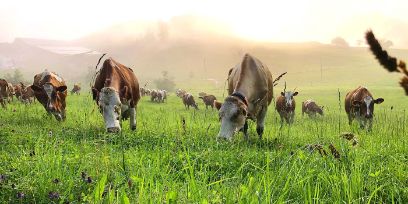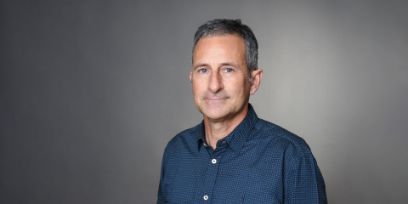- News
Research on food security
23.06.2022 Professor Beat Reidy and his team at the School of Agricultural, Forest and Food Sciences (HAFL) have developed formulae to calculate competition between humans and animals for food and land. It might sound abstract, but it’s an important issue in the discussion on food security, and it should help to make the Swiss dairy industry more efficient and climate-friendly.

They always had something to say. They were interested, cooperative and open. The farm managers that Professor Reidy spoke with as part of his research project left a lasting impression on him: ‘When it comes to sensitive issues such as nitrogen fertilisation and ecological compensation areas, farmers can be very reluctant to talk,’ he explains. ‘In our research project on competition for food and land, it was a different story: they wanted to have a voice and find out exactly how they would be affected by the result on food production.’
Feeding 10 billion people
What kind of research project sparks such great interest among farmers? It’s hardly surprising that researchers are increasingly focusing on maximising efficiency in food production. In future, we’ll need to produce more food for an ever greater number of people on increasingly small areas of land. According to UN forecasts, there will be almost 10 billion people on this planet by 2050. And based on estimates by the Federal Statistical Office (FSO), more than 10 million people will live in Switzerland – around twice as many as in 1990. Food production consumes an ever-increasing amount of natural resources. The demand for animal products has continued to increase globally, while the space required to produce them continues to shrink.
Cows and other ruminants can convert nutrients that are unusable by humans into valuable foods – for example, they can turn grass on Alpine meadows into milk. However, if cows eat grass only, their milk production capacity is reduced. Hence they are also given feed in the form of cereals or soy – i.e. food that can easily be consumed by humans too. This raises some fundamental questions: at what point would we benefit from higher nutritional value if we ingested the food ourselves instead of feeding it to animals first (food competition)? And in what circumstances is it better to grow potatoes or vegetables instead of animal feed (land competition)?
Measuring the dilemma
The two variables of food and land competition thus describe the dilemma between growing animal feed for dairy cattle and food for human consumption. In this context, this is known as ‘feed-food competition’. ‘Up to now, little attention has been paid to this aspect when it comes to evaluating production systems,’ explains Professor Reidy. ‘But given that the world population is continuing to grow, it is important to strive for maximum efficiency of usable agricultural land for the purposes of food production.’ However, this requires the notion of ‘competition’ between animals and humans to be capable of being measured.
This is what Professor Reidy and his team at HAFL, working with Agroscope, the Swiss centre of excellence for agricultural research, set out to do as part of this project. They developed formulae to determine competition for food and land. They then applied these calculation methods on 25 dairy farms across Switzerland. ‘We had to take into account complex questions as part of our calculation, such as: “Which foods are acceptable for humans?”, and, “How hungry are they?”’ explains Professor Reidy.
The same amount of milk, from twice the feed
In the farms studied, competition for food was substantially lower than competition for land. This means all of the farms produced more energy and protein in the form of milk and meat than would have been possible with feed – i.e. if humans had eaten the feed themselves (e.g. corn). The results were quite different when it came to competition for land: most of the farms could produce more nutritional value by directly growing food crops on fields rather than feed. ‘Mountainous areas are the only places where dairy farms can produce more food, as it is much more difficult to grow crops there on account of the topography,’ Professor Reidy points out.
However, Swiss dairy farms are heading in the opposite direction – they are becoming ever larger and are concentrated in the Swiss Plateau. While there were around 150,000 dairy farms in Switzerland in 1950, there were only 28,000 in the year 2000. Nowadays, milk is produced on around 18,000 dairy farms. The amount of milk produced has remained constant since 2000 – however, the concentrated feed needed to produce it has doubled over the same period.
More efficient and climate-friendly
Food producers including aaremilch, Emmi AG and Nestlé Suisse are pledging to make Swiss milk production more efficient and climate-friendly as part of the major project ‘Klimastar’ (www.klimastar-milch.ch). The project will involve the use of methods developed by HAFL and Agroscope to calculate competition for food and land. This means that 300 dairies across Switzerland will have their milk analysed to calculate its carbon footprint and food competition. Reduction measures will then be developed. Food competition can be reduced by using less concentrated feed or by feeding by-products of food processing. Examples of the latter include rapeseed meal, fodder potatoes and spent grain. Bonuses will be paid to farms that make progress in this regard. As a result, by 2028, they are expected to cut their annual greenhouse gas emissions by 12,000 tonnes of CO2eq and improve their feed-food competition by 20 per cent.
The project is being funded by the Federal Office for Agriculture (FOAG). Professor Beat Reidy and his team are leading the research. Professor Jan Grenz, lecturer inprofessor for sustainability at HAFL, is also participating in the project. He and his team are involved in the aspects that relate to sustainability and climate. One thing is certain: the lively conversations with farmers are far from over!
Profile

Professor Beat Reidy trained as an agronomist at ETH Zurich. He completed his thesis in collaboration with the Grassland Sciences and Crop Physiology group at the Institute of Plant Sciences at ETH Zurich. Having held a number of positions in the private sector and scientific institutions, he joined HAFL in 2011. He now works as a Professor for Grassland Management and Ruminant Production Systems. As the youngest in a family with three older sisters, he grew up on a farm in the canton of Fribourg, and was expected to take over the business from his parents. He opted to go down the scientific route instead, but nowadays he’s back running the farm with a farm manager, where they specialise in suckler cows, pigs and seed production.